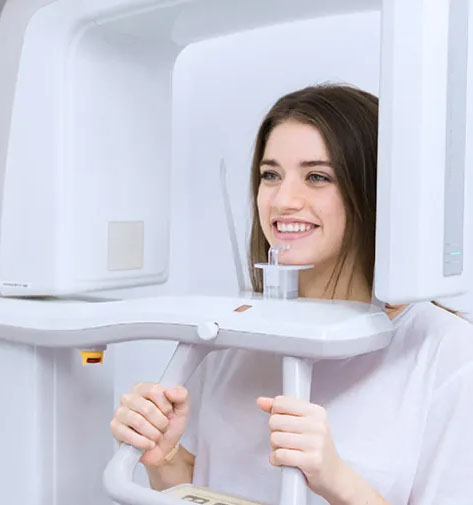3D CBCT Imaging
 What is the Cone Beam CT Scan (3D Scan)?
What is the Cone Beam CT Scan (3D Scan)?
Cone Beam CT Scan, or CBCT, is a specialized type of computed tomography (CT) imaging that focuses on capturing images of the oral and maxillofacial region. It employs a cone-shaped X-ray beam and a detector to capture a series of images from different angles, creating a three-dimensional representation of the scanned area. CBCT provides comprehensive information about the bone structure, teeth, nerves, soft tissues, and airways, aiding in the diagnosis and treatment planning of various dental and oral conditions.
How Does the Cone Beam CT Scan (3D Scan) Work?
CBCT scans are highly advantageous for a wide range of dental applications, including implant planning, orthodontics, endodontics, periodontics, oral and maxillofacial surgery, and evaluation of pathology or trauma. The detailed 3D images provided by CBCT assist in precise treatment decisions, improving patient care and outcomes while minimizing potential risks.
Benefits of Cone Beam CT Scan (3D Scan)?
- Accurate and Comprehensive Imaging: Cone Beam CT Scan provides highly detailed and three-dimensional images of the teeth, jaws, and facial structures. This level of precision enables dental professionals to analyze anatomical structures, identify dental conditions, and plan treatments with accuracy.
- Minimal Radiation Exposure: Compared to traditional medical CT scans, Cone Beam CT Scan involves a lower radiation dose, making it a safer option for patients. The technology focuses the X-ray beam only on the area of interest, reducing unnecessary radiation exposure to other parts of the body.
- Quick and Convenient Scanning Process: Cone Beam CT Scans are typically faster and more comfortable for patients compared to traditional CT scans. The scanning process is efficient and captures images in a single rotation, minimizing the time required for image acquisition.
- The three-dimensional images provided by Cone Beam CT Scan allow for precise treatment planning in various dental procedures. It aids in determining optimal implant placement, identifying the size and position of pathology or abnormalities, and evaluating the relationship between teeth, bones, and other structures.
- Improved Patient Communication: The detailed 3D images generated by Cone Beam CT Scan help dental professionals explain diagnoses and treatment plans to patients more effectively. Visualizing the dental condition and treatment outcomes enhances patient understanding, leading to informed decision-making.
- Compatibility with Digital Dentistry: Cone Beam CT Scans integrate seamlessly with digital dentistry workflows. The three-dimensional images can be easily shared and utilized in conjunction with other digital tools such as intraoral scanners, CAD/CAM systems, and virtual treatment planning software.
